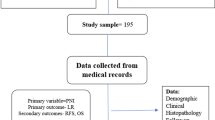Abstract
Background
Head and neck cancer represents 5–10% of all malignancies. Squamous cell carcinoma (SCC) of the oral cavity represents about 2% of overall malignant neoplasms and 47% of the head and neck region. Squamous cell carcinoma of tongue has a peculiar behavior of occult and skips metastasis to regional lymph nodes. It occasionally occurs along with floor of the mouth. The purpose of this study is to evaluate the significance of correlation between, depth of invasion of the primary tumor, its proximity with the neurovascular bundle and subsequent perineural invasion and cervical lymph node metastasis in squamous cell carcinoma tongue and floor of the mouth and the sites involving both.
Materials and Methods
A total of 108 patients with carcinoma tongue (59), floor of the mouth (20) and involving both together (29) who underwent treatment during January 2015 to June 2017 that were followed up until December 2019 were assessed. Out of 108 patients that were included in the study, 71 patients underwent primary surgery and 37 patients were inoperable (tongue—17, floor of the mouth—9 and involving both together—11).
Results
Perineural invasion was seen in 15 cases of pT1-2 where depth of invasion was less than 1 cm and in 28 cases of pT3-4 where depth of invasion was more than 1cm (p-0.075). Skip metastasis was accounted for 61.9% overall.
Conclusion
The triad of perineural invasion, depth of invasion and tumor size is interrelated and was responsible for cervical lymph node metastasis and prognosis of the disease. Obtaining clear deep margins of the tumor from the mucosal margin and removal of lympho-fatty tissue at the floor of the mouth is an important aspect which gives the indication about prognostic factors like depth of invasion, tumor size, cervical nodal metastasis and recurrence of the disease. High-grade tumors (T3-4), depth of invasion of tumor at 1 cm or > 1 cm, increase the propensity of perineural invasion highly.






Similar content being viewed by others
References
Sinha N et al (2018) The histologic risk model is a useful and inexpensive tool to assess risk of recurrence and death in stage I or II squamous cell carcinoma of tongue and floor of the mouth. Mod Pathol. https://doi.org/10.1038/modpathol.2017.1839,772-779
NCRP-annual reports consolidated report of hospital based cancer registries. https://ncdirindia.org/ncrp/ALL_NCRP_REPORTS/HBCR_REPORT_2012_2014/ALL_CONTENT/PDF_Printed_Version/Preliminary_Pages.pdf.
Varsha BK et al (2015) Perineural invasion in oral squamous cell carcinoma: case series and review of literature. J Oral Maxillofac Pathol 193:335–341
Shah JP (1990) The patterns of cervical lymph node metastases from Squamous carcinomas of the upper aerodigestive tract. Am J Surg 1604:405–409
Wallwork BD, Anderson SR (2007) Squamous cell carcinoma of FOM: tumor thickness and the rate of cervical metastasis. ANZ J Surg 77(9):761–764
Nitya Manoj Pandey CS, Naik BR, Ahamed IM (2003) Pattern of cervical metastasis from carcinoma of the oral tongue. World J Surg Onc. https://doi.org/10.1186/1477-7819-1-10
Ananian SG, Gvetadze SR (2015) Anatomic—histologic study of the floor of the mouth: the lingual lymph nodes. Jpn J Clin Oncol 45(6):547–554
Brown IS (2016) Pathology of perineural spread. J Neurol Surg Part B: Skull Base 77(2):124–130
Miller ME, Palla B (2012) A novel classification system for perineural invasion in noncutaneous head and neck squamous cell carcinoma- histologic subcategories and patient outcomes. Am J Otolaryngol 33(2):212–215
Tang JC, Kim SL (2018) Measuring the depth of perineural invasion in cutaneous squamous cell caricinoma Implications on biopsy technique. Dermatol Surg 44(9l):1170–1173
Binmadi NO, Basile JR (2011) Perineural invasion in oral squamous cell carcinoma: a discussion of significance and review of literature. Oral Oncol 47:1005–1010
Tai SK, Li WY (2013) Perineural invasion in T1 oral squamous cell carcinoma indicates the need for aggressive elective neck dissection. Am J Surg Pathol 37(8):1164–1172
Berdugo J, Thompson LDR (2019) Measuring depth of invasion in early squamous cell carcinoma of the oral tongue: positive deep margin, extratumoral perineural invasion, and other challenges. Head and Neck Pathol 1(2):154–161
dAlessandro AF, Pinto FR (2015) Oral cavity squamous cell carcinoma; factors related to occult lymph node metastasis. Braz J Oto Rhinolaryngol 81(3):248–254
Fukano H, Matsuura H (1997) Depth of invasion as a predictive factor for cervical lymph node metastasis in tongue carcinoma. Head Neck 19(3):205–210
Spiro RH, Huvos AG (1986) Predictive value of tumor thickness in squamous carcinoma confined to the tongue and floor of the mouth. Am J Surg 152(4):345–350
Brown B, Barnes L (1989) Prognostic factors in mobile tongue and floor of the mouth carcinoma. Cancer 64(6):1195–1202
Gonzalez-Moles MA, Esteban F (2002) Importance of tumor thickness measurement in prognosis of tongue cancer. Oral Oncol 38(4):394–397
Lydiatt WM, Patel SG, O’Sullivan B (2017) Head and Neck cancers-Major changes in the American Joint Committee on Cancer Eight edition staging manual. CA Cancer J clinic 67(2): 122–137
Michael L Hinni et al (2013) Surgical margins in head and neck cancer: A contemporary review. Head & Neck Wiley online library (wileyonlinelibrary.com). https://doi.org/10.1002/hed.23110:1362-1370
Author information
Authors and Affiliations
Corresponding author
Additional information
Publisher's Note
Springer Nature remains neutral with regard to jurisdictional claims in published maps and institutional affiliations.
Rights and permissions
About this article
Cite this article
Sudhakar, G.V.S., Das, A., Ranjan, K. et al. The Interrelation Among Triad of Depth of Invasion, Perineural Invasion and Tumor Size in Squamous Cell Carcinoma of Tongue and Floor of the Mouth: An Analytical Appraisal. J. Maxillofac. Oral Surg. 21, 350–357 (2022). https://doi.org/10.1007/s12663-022-01685-7
Received:
Accepted:
Published:
Issue Date:
DOI: https://doi.org/10.1007/s12663-022-01685-7




